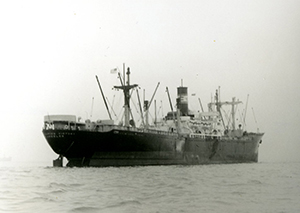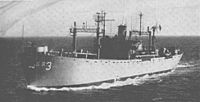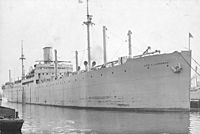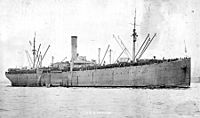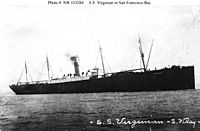Seagoing cowboys facts for kids
Seagoing cowboys were brave people who helped countries recover after World War II. From 1945 to 1947, these cowboys and their ships delivered farm animals to places badly damaged by the war. Organizations like the United Nations Relief and Rehabilitation Administration (UNRRA) and the Brethren Service Committee (part of the Church of the Brethren) led this effort.
These special cowboys made about 360 trips on 73 different ships. Most of these ships were old World War II cargo ships. They were changed to hold animals, with new cages and horse stalls. The Heifers for Relief project started in 1942 and later became Heifer International.
After World War II, many farm animals in Europe had been killed. Groups like the Church of the Brethren, the Society of Friends (Quakers), and the Mennonites helped. They worked with UNRRA to send animals like horses, heifers (young cows), and mules across the ocean. They also sent chicks, rabbits, and goats. The men who took care of these animals on the ships were called seagoing cowboys. Sadly, ten seagoing cowboys died when the SS Park Victory sank on December 25, 1947. This happened after the ship accidentally hit the ground in the Gulf of Finland.
The Seagoing cowboys delivered animals to many countries. These included Albania, China, Czechoslovakia (unloading in Bremen, Germany), Ethiopia, Greece, Italy, Poland, and Yugoslavia (unloading in Trieste, Italy). In total, they moved over 239,000 hoofed animals. More than 7,000 men from the United States and Canada became seagoing cowboys. About 366 of them came from the Civilian Public Service.
Contents
Heifer International: A Lasting Legacy
Heifer International is an organization that grew from these early relief programs. It was started by a member of the Church of the Brethren. Even today, Heifer International helps people around the world. They give heifers and other farm animals to communities to help them grow their own food. The idea is to "pass on the gift." This means that when an animal has babies, the family who received the first animal gives one of the offspring to another family in need. This way, the help keeps spreading!
Remembering the Seagoing Cowboys
People still remember the important work of the seagoing cowboys.
Exhibits and Conferences
On May 10, 2010, some of the surviving Seagoing Cowboys visited Funderburg Library. This was at Manchester College in North Manchester, Indiana. They were there for the opening of a special exhibit about the Seagoing Cowboys. This exhibit was created by Dan West and Heifer International.
A conference was held from August 12–14, 2005, to celebrate 60 years since these efforts began. It took place at the Church of the Brethren Service Center in New Windsor, Maryland.
At this conference, they shared a special message. From 1946 to 1948, over 4,000 cows traveled through Union Bridge, Maryland. They were on their way to the port of Baltimore. There, they were loaded onto ships headed for Europe. The "seagoing cowboys" who cared for these animals came from farms all over America. Their main goal was to provide milk to children and families in war-torn Europe. They did this by replacing lost farm animals. This project was known as Heifer Relief.
One of these cowboys later became a famous scientist named Owen Gingerich.
Ships That Carried Hope
Many different types of ships were used to carry the animals.
- 23 Liberty ships were used:
- Stephen R. Mallory, Wesley Barrett, William D. Bloxham, Tobias E. Stansbury, John Barton Payne, Frederic C. Howe, Dudley H. Thomas, Robert W. Hart, and Rafael R. Rivera. (These ships carried about 15 seagoing cowboys and 340 horses per trip).
- US Army Mule Liberty ships: Santiago Iglesias, William S. Halsted, Charles W. Wooster, Henry Dearborn, William J. Palmer, Cyrus W. Field, John J. Crittenden, Samuel H. Walker, Alcee Fortier, Joshua Hendy, and Zona Gale. (These also carried 15 seagoing cowboys).
- Type C4-class ship: Mount Whitney. (This ship carried 80 cowboys and made five trips to Poland with about 1,500 horses each time).
- Three WWI Army cattle ships: F. J. Luckenbach, Mexican, Virginian.
- 46 Victory ships were used. Each trip had about 32 cowboys. These ships were temporary conversions of WW2 cargo ships. Each made 3 to 8 trips, carrying about 750 horses per trip.
- SS Adrian Victory
- SS Attleboro Victory
- SS Battle Creek Victory
- SS Beloit Victory
- SS Blue Island Victory
- SS Boulder Victory
- SS Bucknell Victory
- SS Calvin Victory
- SS Cedar Rapids Victory
- SS Carroll Victory
- SS Clarksville Victory
- SS Creighton Victory
- SS DePauw Victory
- SS Earlham Victory
- SS Jefferson City Victory
- SS Gainesville Victory
- SS Hattiesburg Victory
- SS Harvard Victory
- SS Flagstaff Victory
- SS Frontenac Victory
- SS Lahaina Victory
- SS Lanaina Victory
- SS Lindenwood Victory
- SS Norwalk Victory
- SS Moline Victory
- SS Morgantown Victory
- SS Mercer Victory
- SS Occidental Victory
- SS Ouachita Victory
- SS Park Victory (This ship sank, and 10 crew members were lost).
- SS Pass Christian Victory
- SS Pierre Victory
- SS Plymouth Victory
- SS Saginaw Victory
- SS Santa ClaraVictory
- SS Spartanburg Victory
- SS South Bend Victory
- SS Roswell Victory
- SS Rockland Victory
- SS Rock Hill Victory
- SS Queens Victory
- SS Woodstock Victory
- SS Villanova Victory
- SS Virginia City Victory
- SS Wesleyan Victory
- SS Yugoslavia Victory
See also
- List of Victory ships
- Liberty ship
- Type C2 ship
- Type C3 ship



